中国文化介绍--中英文对照
- 格式:pdf
- 大小:92.35 KB
- 文档页数:17
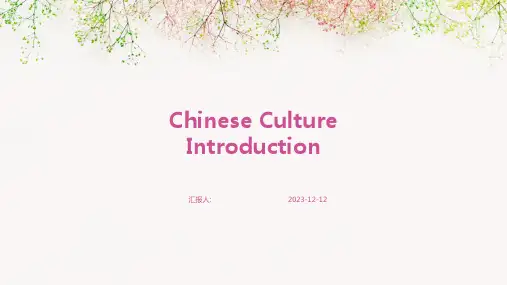
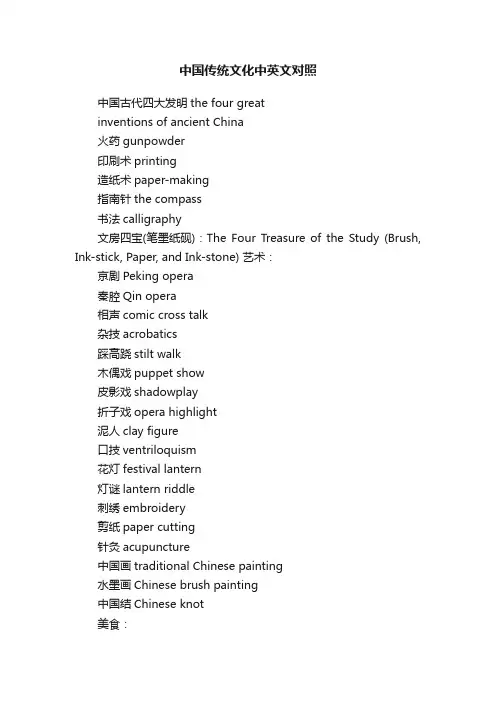
中国传统文化中英文对照中国古代四大发明the four greatinventions of ancient China火药gunpowder印刷术printing造纸术paper-making指南针the compass书法calligraphy文房四宝(笔墨纸砚):The Four Treasure of the Study (Brush, Ink-stick, Paper, and Ink-stone) 艺术:京剧Peking opera秦腔Qin opera相声comic cross talk杂技acrobatics踩高跷stilt walk木偶戏puppet show皮影戏shadowplay折子戏opera highlight泥人clay figure口技ventriloquism花灯festival lantern灯谜lantern riddle刺绣embroidery剪纸paper cutting针灸acupuncture中国画traditional Chinese painting水墨画Chinese brush painting中国结Chinese knot美食:小吃摊snack bar/snack stand月饼moon cake年糕rice cake油条deep-fried dough sticks豆浆soybean milk馒头steamed buns花卷steamed twisted rolls包子steamed stuffed buns拉面hand-stretched noodles馄饨wonton (dumplings in soup)豆腐tofu; bean curd麻花fried dough twist蛋炒饭fried rice with egg节日:春节:the Spring Festival元宵节:the Lantern Festival清明节:the Tomb-sweeping Day端午节:the Dragon-boat Festival中秋节:the Mid-autumn Day重阳节:the Double-ninth Day七夕节:the Double-seventh Day名著:《大学》The Great Learning《中庸》The Doctrine of the Mean 《论语》The Analects of Confucius 《孟子》The Mencius《孙子兵法》The Art of War《三国演义》Three Kingdoms《西游记》Journey to the West《红楼梦》Dream of the Red Mansions《水浒传》Heroes of the Marshes《山海经》The Classic of Mountains and Rivers 《资治通鉴》History as a Mirror《春秋》The Spring and Autumn Annals《史记》Historical Records《诗经》The Book of Songs《易经》The Book of Changes《礼记》The Book of Rites《三字经》Three-character Scriptures旅游景点:秦始皇陵the Mausoleum of Emperor Qinshihuang 兵马俑Terracotta Warriors and Horses大雁塔Big Wild Goose Pagoda丝绸之路the Silk Road敦煌莫高窟Mogao Grottoes华清池Huaqing Hot Springs五台山Wutai Mountain九华山Jiuhua Mountain蛾眉山Mount Emei泰山Mount Tai黄山Mount Huangshan; the YellowMountain故宫the Imperial Palace天坛the Temple of Heaven苏州园林Suzhou gardens西湖West Lake九寨沟Jiuzhaigou Valley日月潭Sun Moon Lake布达拉宫Potala Palace。
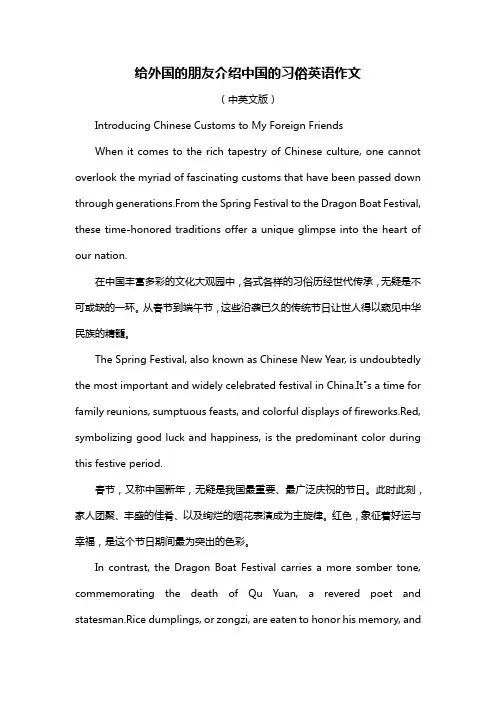
给外国的朋友介绍中国的习俗英语作文(中英文版)Introducing Chinese Customs to My Foreign FriendsWhen it comes to the rich tapestry of Chinese culture, one cannot overlook the myriad of fascinating customs that have been passed down through generations.From the Spring Festival to the Dragon Boat Festival, these time-honored traditions offer a unique glimpse into the heart of our nation.在中国丰富多彩的文化大观园中,各式各样的习俗历经世代传承,无疑是不可或缺的一环。
从春节到端午节,这些沿袭已久的传统节日让世人得以窥见中华民族的精髓。
The Spring Festival, also known as Chinese New Year, is undoubtedly the most important and widely celebrated festival in China.It"s a time for family reunions, sumptuous feasts, and colorful displays of fireworks.Red, symbolizing good luck and happiness, is the predominant color during this festive period.春节,又称中国新年,无疑是我国最重要、最广泛庆祝的节日。
此时此刻,家人团聚、丰盛的佳肴、以及绚烂的烟花表演成为主旋律。
红色,象征着好运与幸福,是这个节日期间最为突出的色彩。

中国文化(中英文对照)中国文化(中英文对照)1. 元宵节:Lantern Festival2. 刺绣:embroidery3. 重阳节:Double-Ninth Festival4. 清明节:Tomb sweeping day5. 剪纸:Paper Cutting6. 书法:Calligraphy7. 对联:(Spring Festival) Couplets8. 象形文字:Pictograms/Pictographic Characters9. 人才流动:Brain Drain/Brain Flow10. 四合院:Siheyuan/Quadrangle11. 战国:Warring States12. 风水:Fengshui/Geomantic Omen13. 铁饭碗:Iron Bowl14. 函授部:The Correspondence Department15. 集体舞:Group Dance16. 黄土高原:Loess Plateau17. 红白喜事:Weddings and Funerals18. 中秋节:Mid-Autumn Day19. 结婚证:Marriage Certificate20. 儒家文化:Confucian Culture21. 附属学校:Affiliated school22. 古装片:Costume Drama23. 武打片:Chinese Swordplay Movie24. 元宵:Tangyuan/Sweet Rice Dumpling (Soup)25. 一国两制:One Country, Two Systems26. 火锅:Hot Pot27. 四人帮:Gang of Four28. 《诗经》:The Book of Songs29. 素质教育:Essential-qualities-oriented Education30. 《史记》:Historical Records/Records of the Grand Historian31. 大跃进:Great Leap Forward (Movement)32. 《西游记》:The Journey to the West33. 除夕:Chinese New Year’s Eve/Eve of the Spring Festival34. 针灸:Acupuncture35. 唐三彩:Tri-color Pottery of the T ang Dynasty/ The Tang Tri-colored pottery36. 中国特色的社会主义:Chinese-charactered Socialist/Socialist with Chinese characteristics37. 偏旁:radical38. 孟子:Mencius39. 亭/阁:Pavilion/ Attic40. 大中型国有企业:Large and Medium-sized State-owned Enterprises41. 火药:gunpowder42. 农历:Lunar Calendar43. 印/玺:Seal/Stamp44. 物质精神文明建设:The Construction of Material Civilization and Spiritual Civilization45. 京剧:Beijing Opera/Peking Opera46. 秦腔:Crying of Qin People/Qin Opera47. 太极拳:Tai Chi48. 独生子女证:The Certificate of One-child49. 天坛:Altar of Heaven in Beijing50. 小吃摊:Snack Bar/Snack Stand51. 红双喜:Double Happiness52. 政治辅导员:Political Counselor/School Counselor53. 春卷:Spring Roll(s)54. 莲藕:Lotus Root55. 追星族:Star Struck56. 故宫博物院:The Palace Museum57. 相声:Cross-talk/Comic Dialogue58. 下岗:Lay off/Laid off59. 北京烤鸭:Beijing Roast Duck60. 高等自学考试:Self-taught Examination of Higher Education61. 烟花爆竹:fireworks and firecracker62. 敦煌莫高窟:Mogao Caves63. 电视小品:TV Sketch/TV Skit64. 香港澳门同胞:Compatriots from Hong Kong and Macao65. 文化大革命:Cultural Revolution66. 长江中下游地区:The Mid-low Reaches of Yangtze River67. 门当户对:Perfect Match/Exact Match68. 《水浒》:Water Margin/Outlaws of the Marsh69. 中外合资企业:Joint Ventures70. 文房四宝(笔墨纸砚):"The Four Treasure of the Study" "Brush, Inkstick, Paper, and Inkstone"71. 兵马俑:cotta Warriors/ Terracotta Army72. 旗袍:cheongsam。
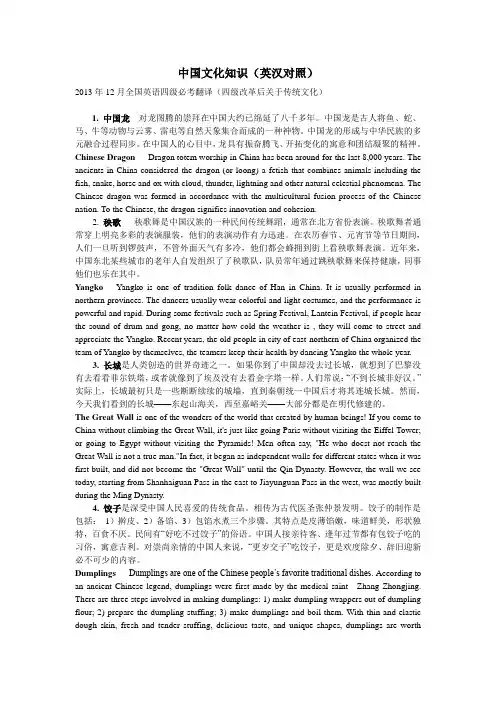
中国文化知识(英汉对照)2013年12月全国英语四级必考翻译(四级改革后关于传统文化)1. 中国龙对龙图腾的崇拜在中国大约已绵延了八千多年。
中国龙是古人将鱼、蛇、马、牛等动物与云雾、雷电等自然天象集合而成的一种神物。
中国龙的形成与中华民族的多元融合过程同步。
在中国人的心目中,龙具有振奋腾飞、开拓变化的寓意和团结凝聚的精神。
Chinese Dragon Dragon totem worship in China has been around for the last 8,000 years. The ancients in China considered the dragon (or loong) a fetish that combines animals including the fish, snake, horse and ox with cloud, thunder, lightning and other natural celestial phenomena. The Chinese dragon was formed in accordance with the multicultural fusion process of the Chinese nation. To the Chinese, the dragon signifies innovation and cohesion.2. 秧歌秧歌舞是中国汉族的一种民间传统舞蹈,通常在北方省份表演。
秧歌舞者通常穿上明亮多彩的表演服装,他们的表演动作有力迅速。
在农历春节、元宵节等节日期间,人们一旦听到锣鼓声,不管外面天气有多冷,他们都会蜂拥到街上看秧歌舞表演。
近年来,中国东北某些城市的老年人自发组织了了秧歌队,队员常年通过跳秧歌舞来保持健康,同事他们也乐在其中。
Yangko Yangko is one of tradition folk dance of Han in China. It is usually performed in northern provinces. The dancers usually wear colorful and light costumes, and the performance is powerful and rapid. During some festivals such as Spring Festival, Lantein Festival, if people hear the sound of drum and gong, no matter how cold the weather is , they will come to street and appreciate the Yangko. Recent years, the old people in city of east-northern of China organized the team of Yangko by themselves, the teamers keep their health by dancing Yangko the whole year.3. 长城是人类创造的世界奇迹之一。
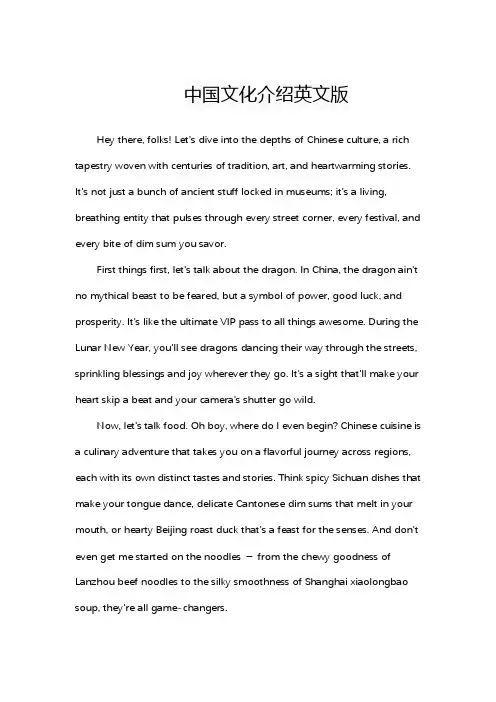
中国文化介绍英文版Hey there, folks! Let's dive into the depths of Chinese culture, a rich tapestry woven with centuries of tradition, art, and heartwarming stories. It's not just a bunch of ancient stuff locked in museums; it's a living, breathing entity that pulses through every street corner, every festival, and every bite of dim sum you savor.First things first, let's talk about the dragon. In China, the dragon ain't no mythical beast to be feared, but a symbol of power, good luck, and prosperity. It's like the ultimate VIP pass to all things awesome. During the Lunar New Year, you'll see dragons dancing their way through the streets, sprinkling blessings and joy wherever they go. It's a sight that'll make your heart skip a beat and your camera's shutter go wild.Now, let's talk food. Oh boy, where do I even begin? Chinese cuisine is a culinary adventure that takes you on a flavorful journey across regions, each with its own distinct tastes and stories. Think spicy Sichuan dishes that make your tongue dance, delicate Cantonese dim sums that melt in your mouth, or hearty Beijing roast duck that's a feast for the senses. And don't even get me started on the noodles –from the chewy goodness of Lanzhou beef noodles to the silky smoothness of Shanghai xiaolongbao soup, they're all game-changers.But Chinese culture isn't just about food and dragons. It's about family, too. The saying goes, "East or west, home is best," and in China, that sentiment rings true louder than a firecracker on New Year's Eve. Families gather around the table during holidays, sharing stories, laughter, and of course, more food. It's a time when the bonds of love and tradition are strengthened, and memories are made to last a lifetime.Art and calligraphy hold a special place in Chinese hearts. Calligraphy isn't just about writing neatly; it's a form of meditation, an expression of the artist's soul. Each stroke, each curve, tells a story, conveying emotions and meanings beyond words. And Chinese paintings? They're like windows into another world, where mountains tower majestically, rivers flow gently, and clouds dance gracefully. They invite you to slow down, take a deep breath, and appreciate the beauty around you.Oh, and let's not forget martial arts. Kung fu, Tai Chi, and Wushu –these aren't just about flipping and kicking (though they can be pretty darn impressive). They're about discipline, focus, and harmony with oneself and the universe. Watching a master practitioner at work is like watching poetry in motion, each movement flowing seamlessly into the next.In conclusion, Chinese culture is a vast, vibrant ocean that invites you to dive in and explore. It's a world of dragons and dim sums, calligraphy and martial arts, where family ties are strong, and tradition is cherished. So the next time you have the chance, grab a pair of chopsticks, put on yourcomfiest clothes, and immerse yourself in this amazing culture. You won't regret it –trust me, I'm not just saying that because I'm biased. It's the real deal, folks!。
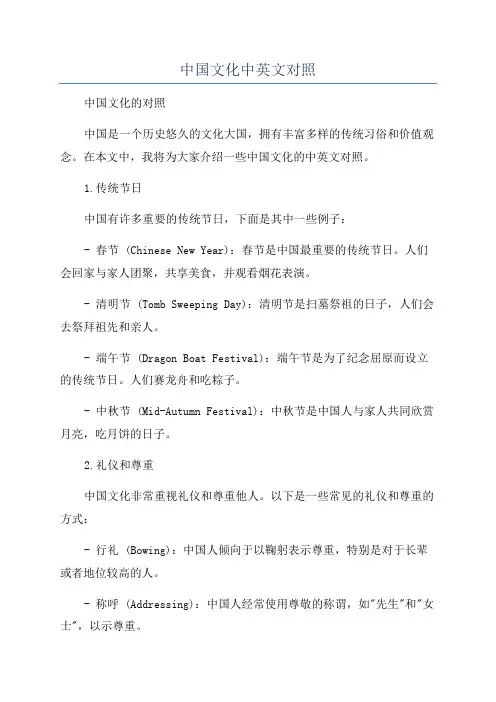
中国文化中英文对照中国文化的对照中国是一个历史悠久的文化大国,拥有丰富多样的传统习俗和价值观念。
在本文中,我将为大家介绍一些中国文化的中英文对照。
1.传统节日中国有许多重要的传统节日,下面是其中一些例子:- 春节 (Chinese New Year):春节是中国最重要的传统节日。
人们会回家与家人团聚,共享美食,并观看烟花表演。
- 清明节 (Tomb Sweeping Day):清明节是扫墓祭祖的日子,人们会去祭拜祖先和亲人。
- 端午节 (Dragon Boat Festival):端午节是为了纪念屈原而设立的传统节日。
人们赛龙舟和吃粽子。
- 中秋节 (Mid-Autumn Festival):中秋节是中国人与家人共同欣赏月亮,吃月饼的日子。
2.礼仪和尊重中国文化非常重视礼仪和尊重他人。
以下是一些常见的礼仪和尊重的方式:- 行礼 (Bowing):中国人倾向于以鞠躬表示尊重,特别是对于长辈或者地位较高的人。
- 称呼 (Addressing):中国人经常使用尊敬的称谓,如"先生"和"女士",以示尊重。
- 饮食礼仪 (Dining Etiquette):在中国,礼仪是饮食文化中不可缺少的一部分。
例如,在用筷子吃饭时,不应该插在饭碗中立起来,因为这会被视为不吉利的行为。
3.文物和建筑中国拥有世界上许多著名的文物和建筑,代表着悠久的历史和独特的文化。
- 长城 (Great Wall):长城是中国最著名的建筑之一,也是世界七大奇迹之一、它是中国古代的防御工事,总长超过21,000公里。
- 故宫 (The Forbidden City):故宫是位于北京的一座宫殿建筑,曾是明清两代24位皇帝的居住地,也是中国历史最长久、规模最大的古代宫殿建筑。
- 兵马俑 (Terracotta Warriors and Horses):兵马俑是位于西安的陶制兵器和马匹的雕像,是中国第一位皇帝秦始皇的陪葬品。
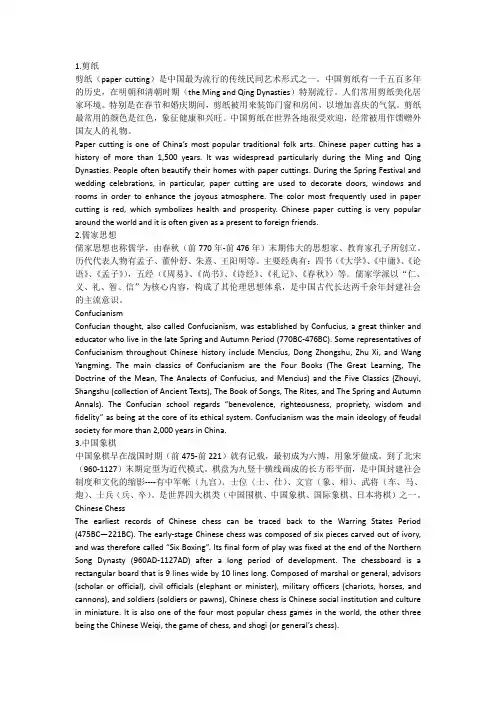
1.剪纸剪纸(paper cutting)是中国最为流行的传统民间艺术形式之一。
中国剪纸有一千五百多年的历史,在明朝和清朝时期(the Ming and Qing Dynasties)特别流行。
人们常用剪纸美化居家环境。
特别是在春节和婚庆期间,剪纸被用来装饰门窗和房间,以增加喜庆的气氛。
剪纸最常用的颜色是红色,象征健康和兴旺。
中国剪纸在世界各地很受欢迎,经常被用作馈赠外国友人的礼物。
Paper cutting is one of China’s most popular traditional folk arts. Chinese paper cutting has a history of more than 1,500 years. It was widespread particularly during the Ming and Qing Dynasties. People often beautify their homes with paper cuttings. During the Spring Festival and wedding celebrations, in particular, paper cutting are used to decorate doors, windows and rooms in order to enhance the joyous atmosphere. The color most frequently used in paper cutting is red, which symbolizes health and prosperity. Chinese paper cutting is very popular around the world and it is often given as a present to foreign friends.2.儒家思想儒家思想也称儒学,由春秋(前770年-前476年)末期伟大的思想家、教育家孔子所创立。
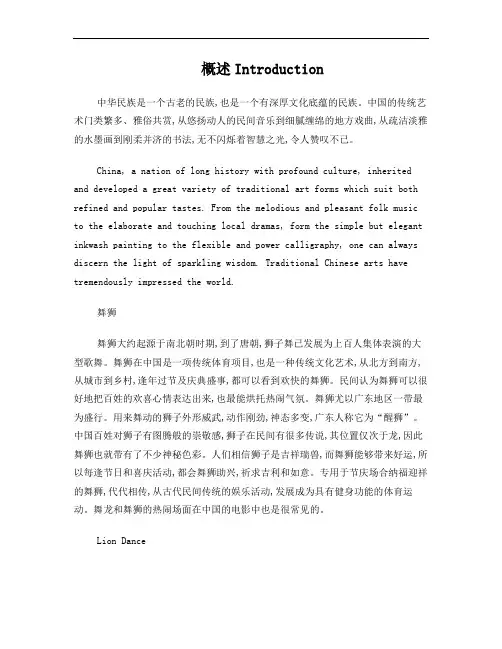
概述Introduction中华民族是一个古老的民族,也是一个有深厚文化底蕴的民族。
中国的传统艺术门类繁多、雅俗共赏,从悠扬动人的民间音乐到细腻缠绵的地方戏曲,从疏洁淡雅的水墨画到刚柔并济的书法,无不闪烁着智慧之光,令人赞叹不已。
China, a nation of long history with profound culture, inherited and developed a great variety of traditional art forms which suit both refined and popular tastes. From the melodious and pleasant folk music to the elaborate and touching local dramas, form the simple but elegant inkwash painting to the flexible and power calligraphy, one can always discern the light of sparkling wisdom. Traditional Chinese arts have tremendously impressed the world.舞狮舞狮大约起源于南北朝时期,到了唐朝,狮子舞已发展为上百人集体表演的大型歌舞。
舞狮在中国是一项传统体育项目,也是一种传统文化艺术,从北方到南方,从城市到乡村,逢年过节及庆典盛事,都可以看到欢快的舞狮。
民间认为舞狮可以很好地把百姓的欢喜心情表达出来,也最能烘托热闹气氛。
舞狮尤以广东地区一带最为盛行。
用来舞动的狮子外形威武,动作刚劲,神态多变,广东人称它为“醒狮”。
中国百姓对狮子有图腾般的崇敬感,狮子在民间有很多传说,其位置仅次于龙,因此舞狮也就带有了不少神秘色彩。
人们相信狮子是吉祥瑞兽,而舞狮能够带来好运,所以每逢节日和喜庆活动,都会舞狮助兴,祈求吉利和如意。
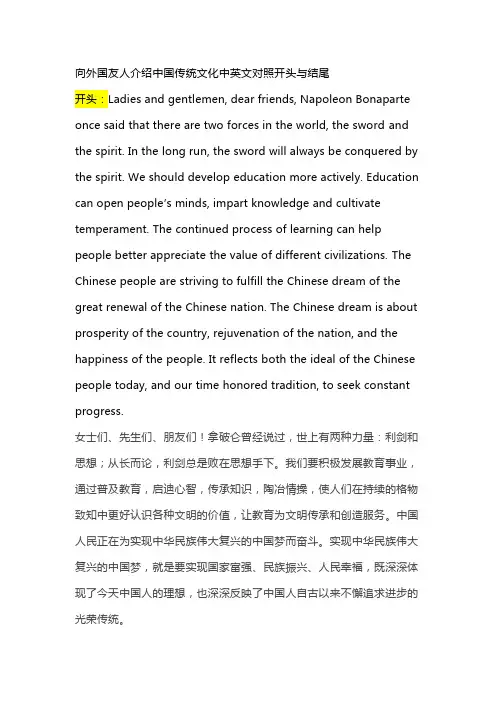
向外国友人介绍中国传统文化中英文对照开头与结尾开头:Ladies and gentlemen, dear friends, Napoleon Bonaparte once said that there are two forces in the world, the sword and the spirit. In the long run, the sword will always be conquered by the spirit. We should develop education more actively. Education can open people’s minds, impart knowledge and cultivate temperament. The continued process of learning can help people better appreciate the value of different civilizations. The Chinese people are striving to fulfill the Chinese dream of the great renewal of the Chinese nation. The Chinese dream is about prosperity of the country, rejuvenation of the nation, and the happiness of the people. It reflects both the ideal of the Chinese people today, and our time honored tradition, to seek constant progress.女士们、先生们、朋友们!拿破仑曾经说过,世上有两种力量:利剑和思想;从长而论,利剑总是败在思想手下。
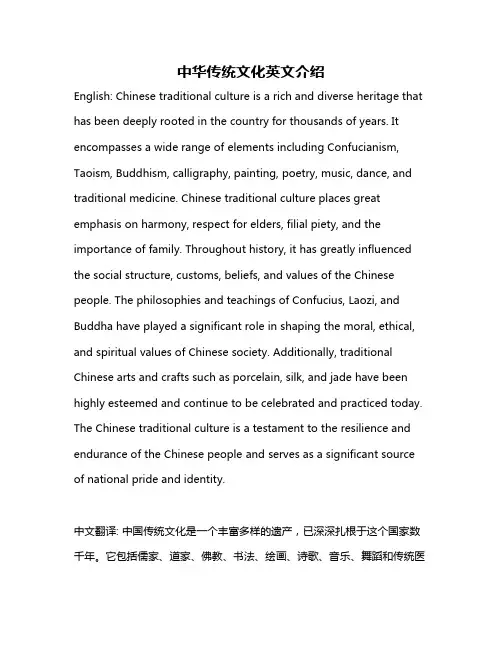
中华传统文化英文介绍English: Chinese traditional culture is a rich and diverse heritage that has been deeply rooted in the country for thousands of years. It encompasses a wide range of elements including Confucianism, Taoism, Buddhism, calligraphy, painting, poetry, music, dance, and traditional medicine. Chinese traditional culture places great emphasis on harmony, respect for elders, filial piety, and the importance of family. Throughout history, it has greatly influenced the social structure, customs, beliefs, and values of the Chinese people. The philosophies and teachings of Confucius, Laozi, and Buddha have played a significant role in shaping the moral, ethical, and spiritual values of Chinese society. Additionally, traditional Chinese arts and crafts such as porcelain, silk, and jade have been highly esteemed and continue to be celebrated and practiced today. The Chinese traditional culture is a testament to the resilience and endurance of the Chinese people and serves as a significant source of national pride and identity.中文翻译: 中国传统文化是一个丰富多样的遗产,已深深扎根于这个国家数千年。
Unit1 中国丝绸中国是丝绸的故乡。
栽桑、养蚕、缫丝、织绸是中国古代人民的伟大发明。
商周时期(前1600——前256)丝绸的生产技术就已发展到相当高的水平。
西汉(前206——公元25)时张蹇通西域,把中元与波斯湾、地中海紧密联系起来,开辟了中外交流贸易的新纪元。
从此中国的丝绸以其卓越的品质、精美的花色和丰富的文化内涵闻名于世,成为中国文化的象征、东方文明的使者。
Chinese SilkChina is the home of silk. Mulberry planting, sericulture, silk reeling and thickening are all great inventions of the ancient Chinese. As early as the Shang and Zhou Dynasties (1600-BC256BC), the Chinese people’s silk-weaving techniques had reached an extremely high level. During the Western Han Dynasty(206BC-25AD),Zhang Jian ,an outstanding diplomat ,traveled around central Asia and connected China with the Persian Gulf and the Mediterranean, opening up a new era of Sino-foreign trade, exchange and communication. From then on, China’s silk became well known for its extraordinary quality, exquisite design and color , and abundant cultural connotations. Hitherto, Chinese silk has been accepted as a symbol of Chinese culture and the emissary of oriental civilization.Unit 2 中国园林中国园林是把人造的山水、植物、建筑等与自然地貌有机结合的环境艺术,是我国古代建筑艺术的珍宝。
中国文化概况英汉对照版中国文化概况英汉对照版一:英文版:Chinese culture, with its rich heritage spanning thousands of years, is one of the oldest and most diverse cultures in the world. It is a blend of traditions, art, philosophy, and customs that have been shaped by the vast and diverse geography of China. From the ancient times of the Yellow Emperor and Confucius to the modern era, Chinese culture has continuously evolved while maintaining its unique identity.At the heart of Chinese culture lies its philosophical traditions, including Confucianism, Taoism, and Buddhism. These philosophies have profoundly influenced the moral and social values of the Chinese people. Confucianism, for instance, emphasizes the importance of family, respect for elders, and the pursuit of knowledge and wisdom.Chinese art, another vital aspect of its culture, encompasses a wide range of styles and mediums, including painting, calligraphy, sculpture, and ceramics. Chinese painting, known for its use of brush and ink, often depicts natural landscapes and scenes from history and mythology. Calligraphy, considered both an art and a way to cultivate one's character, is highly revered in Chinese culture.Cuisine is also a significant part of Chinese culture, characterized by its diversity and emphasis on harmony and balance. Chinese cuisine varies greatly from region to region, with each area having its own unique flavors and specialties. Traditional Chinese medicine, with its holistic approach to health, is another important aspect of the culture.Lastly, Chinese festivals and customs play a crucial role in cultural expression. The Spring Festival, or Chinese New Year, is the most important and widely celebrated festival in China. It is a time for family reunions, feasting, and the giving of red envelopes. Other notable festivals include the Dragon Boat Festival, Mid-Autumn Festival, and Lantern Festival, each with its own traditions and significance.汉语对照版:中国文化,拥有数千年的丰富遗产,是世界上最古老、最多样化的文化之一。
中国文化英文介绍(通用3篇)关于中国文化的英文文章篇一Lucky number is part of our cultureTo my way of thinking, the so-called lucky number represents the characteristics of our culture. We Chinese have a tradition: whenever we have important things to do, we always select the day we think lucky. Such as: the “10.10.10” day (October 10, 2010), we regard it as the prefect day. For in our culture, “10” as a very lucky number means everything is perfect.This tradition is gradually formed in history. As we all know, china have a very long history. The nature is very sacred then, and our ancestors try their best in order to gain its help, hoping everything run smooth. So when they were to do things, they usually choose something which indicates good fortune. As the time passes, this habit slowly becomes a tradition, and gradually expands every aspect of life. For example, Chinese people like wear the red clothes, because in our eyes the red indicates positive, smooth, prosperous.Among this, the lucky number is the especial example. Now the number seems to appear everywhere in our daily life. Such as: our telephone number, various bank card number, ID number, VIP card number, house number and so on. The number four looked as unlucky, for its pronunciation sound as the word “death” in Chinese. So is the number seven. However, six, nine, ten are lucky numbers. Affected by this culture, most of us prefer to use the so-called lucky numbers. Therefore there are lots of couples choose the”8.8.8”“9.9.9””10.10.10”day when they marry.All in all, the lucky number is part of our culture. All things we can do are holding a respect and accept of attitude to it.中国文化英文介绍篇二京剧脸谱(Beijing opera types of facial makeup in operas)Beijing opera types of facial makeup in operas, is a special feature of a national cosmetic. As each historical figure or a certain type of person has an approximate spectral type, like sing, play music to the music, so called “types of facial makeup in operas”。
十二属相中国民间有一个传统习俗,人一出生,就有一种动物做他的属相。
属相,也叫“生肖”,是中国民间传统的纪年和计算年龄的方法。
中国古代的纪年法是帝王年号与“干支”并用,其中“干支纪年法”从史书上有明文记载的公元前841年(庚申年),一直沿用到现在。
“干”是“天干”,有十个字组成,这十个字是:甲、乙、丙、丁、戊、己、庚、辛、壬、癸。
“支”是“地支”,由十二个字组成,这十二个字是:子、丑、寅、卯、辰、巳、午、未、申、酉、戌、亥。
把天干的十个字和地支的十二个字按顺序配合起来,可以得到60种排列,如:甲子、乙丑、丙寅……这60种排列周而复始,循环使用,每六十年叫做“一个甲子”。
如公历的2001年,是农历的辛巳年,公历的2002年,是农历的壬午年;而六十年后,2061年又是辛巳年,2062年又是壬午年。
从东汉(25——220)时开始,人们又用鼠、牛、虎、兔、龙、蛇、马、羊、猴、鸡、狗、猪12种动物来配十二地支,组成了十二生肖,也叫十二属相。
这就是子鼠、丑牛、寅虎、卯兔、辰龙、巳蛇、午马、未羊、申猴、酉鸡、戌狗、亥猪。
这样,子年是鼠年,丑年是牛年,寅年是虎年……于是,每个人一出生,就有一种动物作他的属相。
子年出生的属鼠,丑年出生的属牛,寅年出生的属虎,以此类推。
现在,中国人在用公历纪年和计算年龄的同时,仍然习惯用属相纪年和推算年龄。
twelve symbolic animalsit is traditional in China,when a perpon is born,one animal(shuxiang)is used to symbolize this year.Shuxiang,also called shengxiao(any ofthe12animals representing the Earthly Branches),is a traditional way in China to number the years and to record a person's age.The ancient Chinese people invented the method to designate the years by the Heavenly Stems consist of the characters:jia,yi,bing,ding,wu,ji,geng,xin,ren,and gui.And the Earthly Branches are composed of12characters:zi,shu,yin,mao,chen,si,wu,wei,shen,you,xu,bining each of the 10Heavenly Stems with one of the12Earthly Branches in sequence creates60 chronological symbols.For example jiazi,yichou,bingyin,etc.These60symbols are used in circles and thus each year has a chronological symbol.For example,2001 corresponds to xinsi,2002to renwu in the lunar calendar;after60years,2061,once again,corresponds to xinsi,and2062,to ter,people used12animalsto correspond to the12Earthly Branches,forming the12Symbolic Animals,namely Earthly Branch One Rat,Earthly Branch Two Ox,Earthly Branch ThreeTiger,Earthly Branch Four Rabbit,Earthly Branch Five Dragon,Earthly Branch Six Snake,Earthly Branch Seven Horse,Earthly Branch Eight Sheep,Earthly Branch Nine Monkey,Earthly Branch Ten Rooster,Earthly Branch Eleven Dog,Earthly Branch Twelve Pig.Thus the zi year is the Year of the Rat,and the chou Year is the year of the Ox,and the yin Year is the Year of the Year ofTiger,etc.Therefore,when a person is born,he has an animal as his aymbolic animal.The year2002was a renwu year under lunar calendar,also the year of Horse,and so children born in this yea are all Horse babies.Even though the Chinese people now number the years and their age under the Gregorian calendar,the still continue to use the symbolic animals.As long as people know a person'probable age and his symbolic animao,people can infer his exact age and year of birth.小孩儿满月与抓周在中国,小孩儿的满月酒和抓周仪式独具特色。
中国文化概况中英版An Overview of Chinese Culture (English Version)I. IntroductionChinese culture, with its long history and profound essence, is the sum of material and spiritual cultures created and passed down by the Chinese nation throughout its historical development. Chinese culture emphasizes humanism, focusing on moral values, etiquette, family, and social order.II. Main Contents1. History and EvolutionChinese culture boasts a rich history spanning thousands of years, from the Xia, Shang, and Zhou dynasties to the Spring and Autumn period, the Warring States period, and then to the Tang, Song, Yuan, Ming, and Qing dynasties. It has continuously absorbed and integrated foreign cultures, forming a unique cultural system.2. Traditional ValuesConfucianism is one of the cornerstones of Chinese culture, emphasizing virtues such as benevolence, filial piety, loyalty, and etiquette, which have profoundly influenced the behavior and values of the Chinese people. Taoism emphasizes the harmony between man and nature, advocating a natural and non-interventionist approach. Buddhism, on the other hand, emphasizes compassion and self-sacrifice, having a significant impact on Chinese religion and philosophy.3. Cultural Characteristics- Festival Culture: China has many traditional festivals, such as the Spring Festival, Mid-Autumn Festival, and Dragon Boat Festival, each with unique celebration methods and cultural connotations.- Clothing Culture: Traditional Chinese clothing, such as Hanfu and Tangzhuang, reflects the unique aesthetic concepts and cultural characteristics of the Chinese nation.- Architectural Culture: Traditional Chinese architecture, including palaces, temples, and gardens, is renowned for its distinctive styles and exquisite craftsmanship.- Cuisine Culture: Chinese cuisine, known for its rich flavors and exquisiteculinary techniques, is an important representation of China's cultural charm.4. Influence on the WorldThe values and ideological systems of Chinese culture have had a profound impact on the world, especially Confucianism, which has influenced Asia and beyond. Traditional Chinese arts and forms of expression, such as calligraphy, painting, and Peking Opera, are also deeply loved and admired by people around the world.III. ConclusionChinese culture is a treasure of the Chinese nation, embodying unique charm and value. Through learning and understanding Chinese culture, we can gain a deeper understanding of the history, traditions, and spiritual outlook of the Chinese people, further enhancing our sense of national pride and self-confidence. At the same time, Chinese culture has also made significant contributions to the diversity and development of world culture.中国文化概况中英版一、引言中国文化,源远流长,博大精深,是中华民族在长期历史发展过程中所创造并传承下来的物质文化和精神文化的总和。
八拜之交:原表示世代有交情的两家弟子谒见对方长辈时的礼节,旧时也称异姓结拜的兄弟姐妹。
●friendship between sworn brothers or sisters●friendship between very close friends whounderstand each other and recommend eachother at the sacrifice of their own interests莫逆之交:bosom friends总角之交:friendship between people who are friends since childhood一般作宾语,指儿时的朋友。
总角:古代未成年的人把头发扎成髻。
借指童年时期,幼年。
总角是八九岁至十三四岁的少年,古代儿童将头发分作左右两半,在头顶各扎成一个结,形如两个羊角,故称“总角”。
贫贱之交:friendship between people who are poverty-stricken and from humble circumstances杵臼之交:friendship between people who do not care about the financial condition and social status of each other 杵:舂米的木棒;臼:石臼。
比喻交朋友不计较贫富和身分。
君子之交:friendship between gentlemen小人之交:friendship between villains狐朋狗友:people who often gather together doing something meaningless and even illegal棋友/牌友/球友:people who often meet to play chess, poker, ball. etc.战友:people who get to know each other while serving in the same army unit普通老百姓交的朋友谓“布衣之交”;有钱人与没钱人交朋友谓“车笠之交”;在逆境中结交的朋友称“患难之交”;吃喝玩乐结交的朋友称“酒肉之交”;年岁差别大,行辈不同而交情深厚的朋友称“忘年之交”;幼年相交的朋友称“竹马之交”;交情深厚的朋友谓“肺腑之交”;亲密无间的朋友谓“胶漆之交”;生死与共的朋友谓“生死之交”;情投意合的朋友称“莫逆之交”;哪怕砍头也不改变友谊的朋友称“刎颈之交”;无意中相遇而结成的朋友称“邂逅之交”;在道义上互相支持的朋友称“君子之交”;只见过一次面,交情不深的朋友称“一面之交”;仅点头打招呼,感情不深的朋友称“点头之交”;平淡而浮泛交往的朋友称“泛泛之交”;见过面但不熟悉的人称“半面之交”;旧时结拜的兄弟姊妹称“八拜之交”;交友不嫌贫贱称“杵逆之交”;宝贵而有价值的交往称“金玉之交”。
十二属相中国民间有一个传统习俗,人一出生,就有一种动物做他的属相。
属相,也叫“生肖”,是中国民间传统的纪年和计算年龄的方法。
中国古代的纪年法是帝王年号与“干支”并用,其中“干支纪年法”从史书上有明文记载的公元前841年(庚申年),一直沿用到现在。
“干”是“天干”,有十个字组成,这十个字是:甲、乙、丙、丁、戊、己、庚、辛、壬、癸。
“支”是“地支”,由十二个字组成,这十二个字是:子、丑、寅、卯、辰、巳、午、未、申、酉、戌、亥。
把天干的十个字和地支的十二个字按顺序配合起来,可以得到60种排列,如:甲子、乙丑、丙寅……这60种排列周而复始,循环使用,每六十年叫做“一个甲子”。
如公历的2001年,是农历的辛巳年,公历的2002年,是农历的壬午年;而六十年后,2061年又是辛巳年,2062年又是壬午年。
从东汉(25——220)时开始,人们又用鼠、牛、虎、兔、龙、蛇、马、羊、猴、鸡、狗、猪12种动物来配十二地支,组成了十二生肖,也叫十二属相。
这就是子鼠、丑牛、寅虎、卯兔、辰龙、巳蛇、午马、未羊、申猴、酉鸡、戌狗、亥猪。
这样,子年是鼠年,丑年是牛年,寅年是虎年……于是,每个人一出生,就有一种动物作他的属相。
子年出生的属鼠,丑年出生的属牛,寅年出生的属虎,以此类推。
现在,中国人在用公历纪年和计算年龄的同时,仍然习惯用属相纪年和推算年龄。
twelve symbolic animalsit is traditional in China,when a perpon is born,one animal(shuxiang)is used to symbolize this year.Shuxiang,also called shengxiao(any ofthe12animals representing the Earthly Branches),is a traditional way in China to number the years and to record a person's age.The ancient Chinese people invented the method to designate the years by the Heavenly Stems consist of the characters:jia,yi,bing,ding,wu,ji,geng,xin,ren,and gui.And the Earthly Branches are composed of12characters:zi,shu,yin,mao,chen,si,wu,wei,shen,you,xu,bining each of the 10Heavenly Stems with one of the12Earthly Branches in sequence creates60 chronological symbols.For example jiazi,yichou,bingyin,etc.These60symbols are used in circles and thus each year has a chronological symbol.For example,2001 corresponds to xinsi,2002to renwu in the lunar calendar;after60years,2061,once again,corresponds to xinsi,and2062,to ter,people used12animalsto correspond to the12Earthly Branches,forming the12Symbolic Animals,namely Earthly Branch One Rat,Earthly Branch Two Ox,Earthly Branch ThreeTiger,Earthly Branch Four Rabbit,Earthly Branch Five Dragon,Earthly Branch Six Snake,Earthly Branch Seven Horse,Earthly Branch Eight Sheep,Earthly Branch Nine Monkey,Earthly Branch Ten Rooster,Earthly Branch Eleven Dog,Earthly Branch Twelve Pig.Thus the zi year is the Year of the Rat,and the chou Year is the year of the Ox,and the yin Year is the Year of the Year ofTiger,etc.Therefore,when a person is born,he has an animal as his aymbolic animal.The year2002was a renwu year under lunar calendar,also the year of Horse,and so children born in this yea are all Horse babies.Even though the Chinese people now number the years and their age under the Gregorian calendar,the still continue to use the symbolic animals.As long as people know a person'probable age and his symbolic animao,people can infer his exact age and year of birth.小孩儿满月与抓周在中国,小孩儿的满月酒和抓周仪式独具特色。
在孩子的成长过程中,这两个仪式有里程碑式的纪念意义。
小孩儿出生满一个月的那天,孩子的家人一般要招呼亲朋挚友,邀请他们一起来庆祝孩子满月。
按照中国的传统,这一天,家里会充满了喜庆和节日的氛围,满月就要办得热热闹闹才行。
不过最近这些年,这个习俗在城市尤其是年轻夫妇中有逐渐被淡化的趋势。
但是,小孩儿满月对于每个家庭来说,仍然是一个非常值得纪念的高兴的日子。
“抓周儿”中的“周”是小孩儿满一周岁的意思。
关于“抓周儿”,最早记载于北齐。
“抓周儿”也就是在小孩儿满周岁那天,吃中午的长寿面之前,摆上经书、笔、墨、纸、砚、算盘、钱币、账册、首饰、花朵、胭脂、吃食、玩具等,如果是女孩儿则要加摆铲子、勺子(炊具)、剪子、尺子(缝纫用具)、绣线、花样子(刺绣用具),再由大人将小孩抱来,令其端坐,父母及他人不给予任何的引导或暗示,任孩子随意挑选,看他先抓什么,后抓什么,并以此为依据来预测孩子可能存在的志趣和将从事的职业以及前途。
One-Month-Old Feast and One-Year-Old Catch(zhuazhou)of babiesIn China,One-Month-Old Feast and One-Year-Old Catch of a baby are of unique Chinese characteristics.These two ceremonies are milestone-like significance in the growing process of a baby.On the day when a baby is a month old,the family of the baby will invite their friends and relatives to a ceremony to celebrate the occasion.In a traditionalOne-Month-Old Ceremony,there will be a rejoicing and festive atmosphere in the family and the feast is supposed to be lively and joyful.However,in recent years this custom has been gradually abandoned among youngpeople.Nevertheless,One-Month-Old Feast still remains a memorable and happy moment for every family.Zhou in the word zhuazhou means"a baby is one year old".The earliest historical record about zhuazhou appearde during the Dynasty of Northern Qi.On the day when ababy is a year old,the family of the baby will lay out sutras,brush pens,ink sticks,paper,ink slabs,abacus,copper coins,accountbooks,jewelries,flowers,rouges,foods,toys,etc.Forgirls,scoops,scissors,rulers,thread,scissor-cut will be added.The parents then put the baby in front of these articles and make it sit up.Nobody will give and instruction or cue to the baby so that it is left free to choose by itself.Watching the baby catch the articles it likes,the family can then make predictions about its potential interests,future career and development.婚礼结婚是人生中的一件大事。
传统的中式婚礼古朴而又热闹,隆重、喜庆并且礼节周全,场面的铺陈颇具特色,不过在现代,尤其是在城市里,已经很少见了。